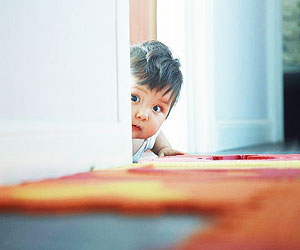Infants Can Tell If You’re a Reliable Informant
 It’s hard to know how babies think, since they’re still getting a handle on language skills. One strategy that researchers use to gain some insight is eye tracking, which allows them to see where babies direct their gaze and for how long.
It’s hard to know how babies think, since they’re still getting a handle on language skills. One strategy that researchers use to gain some insight is eye tracking, which allows them to see where babies direct their gaze and for how long.
In light of research suggesting that children trust other people’s testimony based on prior experience with them, psychological scientist Kristen Swan Tummeltshammer of the Centre for Brain and Cognitive Development at Birkbeck, University of London and colleagues conducted two experiments to determine whether infants could discern a person’s trustworthiness and act on this knowledge — a crucial skill for successful learning.
In the first experiment, 24 8-month-old infants watched a screen on which one of two video-recorded female faces appeared and said, “Wow, look!” When the face turned toward one of the corners of the screen, each of which contained a box, an animated image of an animal accompanied by the appropriate sound appeared, including a barking dog, a croaking frog, a gurgling fish, and a chirping bird.
One of the faces was reliable — every time it turned toward a box, the animal animation appeared in that box. The other face was unreliable — most of the time, an animal appeared in a box that the face was not looking at.
In test trials, however, the animation never appeared; instead, all of the boxes flashed. And sometimes, the face looked at a box it had never turned toward before.
Tummeltshammer and colleagues found that infants seemed to recognize that the reliable face was reliable — that is, they spent more time looking at the box that the reliable face turned toward, regardless of whether the box was familiar or new.
When the unreliable face looked at a box, however, the infants didn’t seem to trust it as a reliable source of information, and they searched among all the boxes to see what might appear.
“These data show that infants do not naively follow gaze; rather, they are sensitive to the relation between an adult’s gaze the locations of objects…and they track this relation over time to evaluate the reliability of adults’ gaze behaviors,” write Tummeltshammer and colleagues.
A second experiment in which the faces were replaced with colorful arrows revealed that infants could also distinguish the reliability of the arrows, but they still searched among all the boxes when the reliable arrow pointed to a box it hadn’t pointed to before.
According to the researchers, it’s possible that infants have simply had more experience with people than with arrows as sources of information, or perhaps they paid attention to the faces and arrows differently.
Tummeltshammer and colleagues conclude that infants’ ability to discern the informativeness of both new and familiar sources of information adds to our understanding of social development:
“Such early capacities to track the reliability of information in the world suggest that infants are capable of learning from other people judiciously at very early ages and that these capacities might be the building blocks of socially constructed knowledge.”
![]()
Tummeltshammer, K., Wu, R., Sobel, D., & Kirkham, N. (2014). Infants track the reliability of potential informants. Psychological Science, 25 (9), 1730-1738. DOI: 10.1177/0956797614540178





Comments
This finding might not have to do with trust of reliability. It only shows that babies can learn: if someone gives a clue you can expect something to happen, so watch out. In fact this learning is very efficient. If the clue does not contain any information on where to look, just look around, because something is coming up sonewhere. We don’t nead to speculate about some kind of mystic ability infants have.
APS regularly opens certain online articles for discussion on our website. Effective February 2021, you must be a logged-in APS member to post comments. By posting a comment, you agree to our Community Guidelines and the display of your profile information, including your name and affiliation. Any opinions, findings, conclusions, or recommendations present in article comments are those of the writers and do not necessarily reflect the views of APS or the article’s author. For more information, please see our Community Guidelines.
Please login with your APS account to comment.